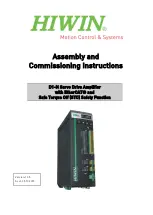
OWNER’S MANUAL
Connect the remote cable
(normally thin blue wire) from the source unit (head unit)’s
remote output. This is called a variety of things including “remote”, “aerial”, “electric
antenna”, “REM” and “remote turn on”. To do this you will need to have access to the
back of the source unit; it will need pulled out. Please refer to the source unit’s manual to
find the right cable.
When the remote cable is attached to the remote output of the source unit, leave the
source unit pulled out for the moment, and run the remote cable to where the amplifier is,
down the same side of the vehicle as the power cable. As with the power cable, try to hide
it under panels and carpet. Again, the wiring kit should have been supplied with
connectors, so cut the cable to length and connect it to the “REM” terminal on the
amplifier, with or without a connector, in the same manner as the power and ground
cables were connected.
Connect the audio signal lead
(RCA phono lead) to the “line level” or “pre-out” of the
source unit. The pre-out of the source unit should be in the form of two RCA phono
sockets. Simply plug your lead into the sockets, ensuring red goes to red, and white (or
black) goes to white (or black).
Then run the lead all the way to the amplifier. To minimise noise, please ensure that the
audio signal lead is run well away from the power leads. It is normally best to
run it
down the opposite side of the car
.
If the cables are too close, a high pitched
whine can get into the system; this is engine noise.
If your source unit has no pre-outs, it is probable that it is not of sufficient quality to work
well with an amplifier; if it is giving poor quality audio then the amplifier will simply
amplify this poor quality audio. However, if a line output converter is purchased, it would
convert speaker outputs to a line level and enable you to operate the amplifier. As
mentioned, the output may not be of a great quality.
Connect the speaker cable
from your speaker(s) to the amplifier. Negative should go to
negative and positive to positive, as illustrated on page 5. It is advisable to cut the
speaker cable to size. However, make sure that the same length is used for each speaker.
Never connect or disconnect speakers when the amplifier is on
; you risk
permanently damaging the speakers.
Once you have checked that all the connections are good and solid, re-connect the
negative terminal of the battery. If anything goes wrong, disconnect it immediately and
investigate. The amplifier’s power LED should be lit. If not, or the protection LED is lit,
please refer to the “Troubleshooting” section.
Finally, all that is left to do is
calibrate the amplifier with the source unit
:
1.
Turn the gain knob on the amplifier all the way down
2.
Play a CD or similar of music or audio that will be typically played
3.
Turn the gain control on the source unit to around 70 – 80% of it’s maximum
4.
Slowly increase the gain knob on the amplifier until you can hear distortion
5.
Turn the gain knob on the amplifier to just before this distortion occurs
6.
Test the system and make any equalisation changes on the source unit or the
amplifier according to taste
7.
If any equalisation changes are made, repeat stages 1 to 7 until satisfied
8.
Never exceed the source unit gain that you used to calibrate the system
Remember:
It is possible for the gain knob to be at only a quarter of its maximum, but
the amplifier is actually outputting to its full potential. This could be because the source
unit is supplying slightly more power than normally expected.
OWNER’S MANUAL
Safety
Health Warning
The Competition Pro range of car audio is built for very high power handling. Listening to
music at such high powers is potentially capable of causing physical side effects such as
nausea or even permanent side effects such as hearing loss. It is therefore absolutely
essential that conservatism and a high sense of judgement is observed when in operation.
TheLoudest.com accepts no liability for hearing disorders, nausea or other side effects
caused by this equipment.
General Safety
Playing loud music in a vehicle can hinder your sense of what is going on around you on
the road, including your ability to hear your own, and other vehicles. We recommend
listening at low or moderate levels while driving.
TheLoudest.com accepts no liability for injury, property damage or otherwise resulting
from the use or misuse of this equipment.
Do not use any chemicals when cleaning this equipment. Please use a clean dry cloth.
Do not install this unit outside the car, or anywhere where it could become damp or humid,
or where it can become exposed to the sun. It should be installed in a dry and ventilated
area inside the car.
Never connect or disconnect speakers when the amplifier is on; this can permanently
damage the speakers. Always do this when it is off.
Never open the amplifier up. Doing so would put you at risk of an electric shock. None of
the internal parts are serviceable by the user. In the case of the unit needing repair or
maintenance, please take it to a qualified professional.
























